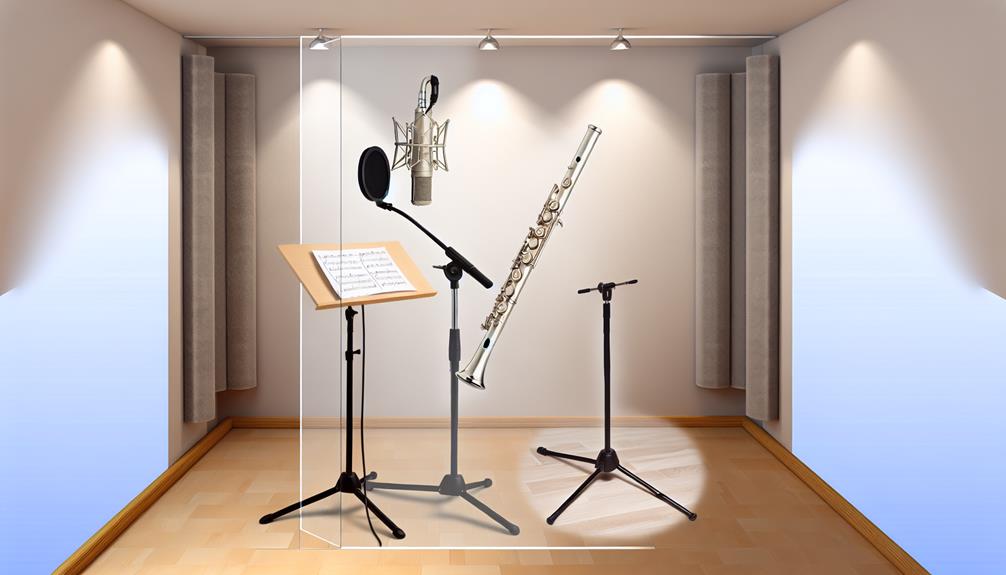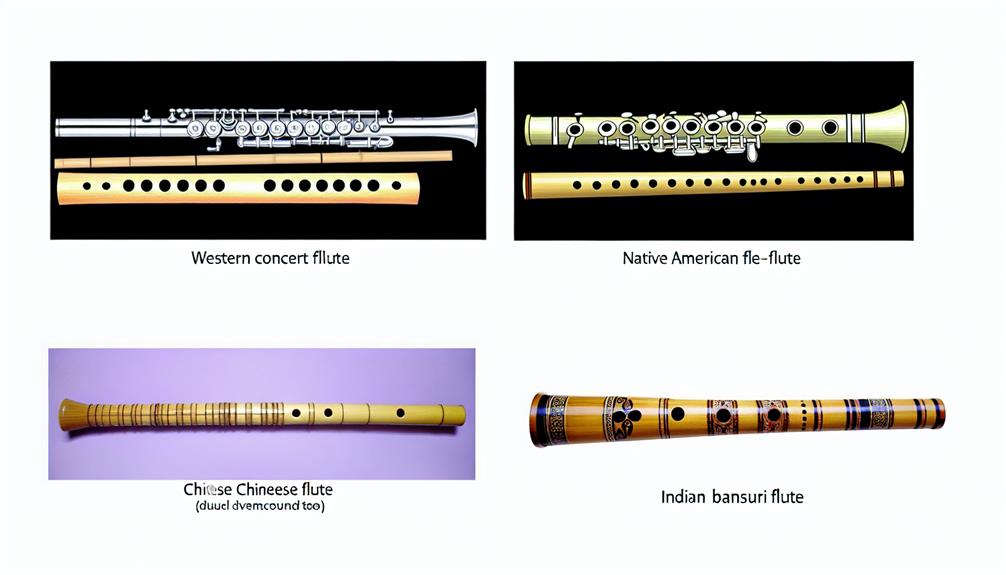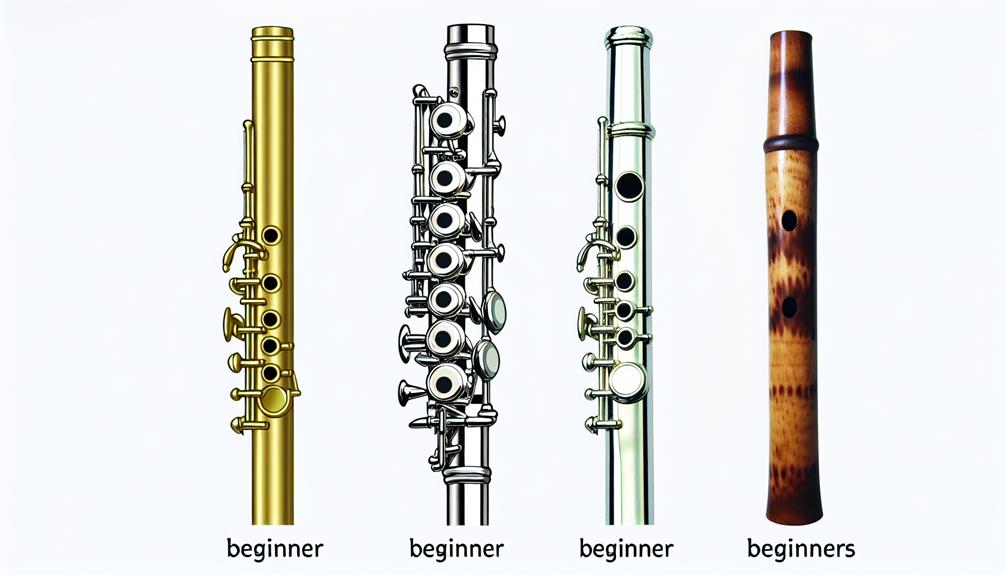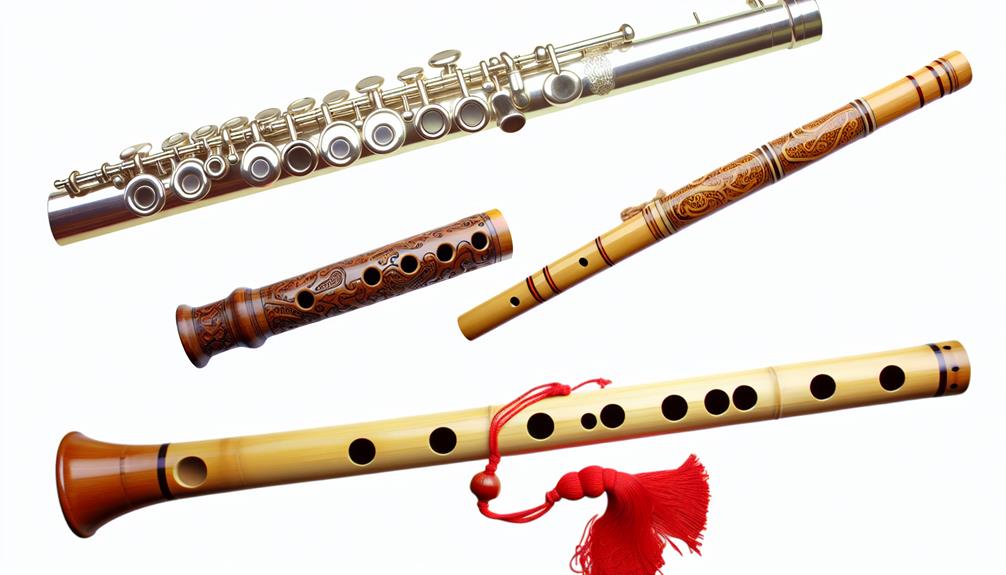In the realm of music, the diversity of instruments often goes unnoticed. When exploring the world of flutes, one may encounter a variety of types, each with its own unique characteristics and sound.
Among the notable mentions are the Concert Flute, Bansuri, Bass Flute, and Piccolo. These four flutes, although distinct in their design and purpose, come together to create a harmonious symphony of melodies.
To uncover the nuances and significance of each flute type, one must journey deeper into the realm of woodwind instruments, where a world of musical possibilities awaits.
Key Takeaways
- Concert Flute: Bright and clear tone, versatile in music settings, made of metals, wide 3-octave range.
- Bansuri: Traditional South Asian bamboo flute, hauntingly melodic, versatile in tones, crafted from bamboo.
- Bass Flute: Deeper, richer tone, larger size one octave below concert flute, warm mellow quality.
- Piccolo: Small, high pitch, bright tone, unique characteristics, adds high-pitched element to ensembles.
Concert Flute
The Concert Flute, also known as the C flute, is a popular member of the woodwind family, known for its bright and clear tone. It is a versatile instrument that is commonly used in orchestras, concert bands, chamber music ensembles, and solo performances. The concert flute typically measures about 26 inches in length and is made of silver, gold, or other metals. Its sound is produced by blowing air across the edge of the mouthpiece hole while pressing the keys to change the pitch.
One of the key features of the concert flute is its wide range, spanning over three octaves. This allows for the performance of a diverse repertoire of music, ranging from classical to contemporary pieces. The flute's agile and nimble nature makes it well-suited for fast and intricate passages, as well as lyrical melodies that soar above the accompaniment.
Many musicians are drawn to the concert flute for its expressive capabilities and ability to convey a wide range of emotions through its pure and resonant sound. Whether playing in a symphony orchestra or a small ensemble, the concert flute offers a sense of belonging to a rich musical tradition.
Bansuri
Originating in South Asia, Bansuri is a traditional bamboo flute known for its hauntingly melodic sound. The Bansuri holds a special place in the hearts of many music enthusiasts, as its soulful tunes evoke a sense of tranquility and connection with nature.
Crafted from a single hollow shaft of bamboo with six or seven finger holes, the Bansuri is played by blowing air through a small aperture near one end.
This enchanting flute is commonly used in classical music and folk music traditions of South Asia, particularly in Indian classical music. The Bansuri's versatility allows it to produce a wide range of tones, making it a popular choice for musicians seeking to express deep emotions through their music. Its soothing melodies have also found their way into contemporary music genres, adding a unique and exotic flair to compositions.
Whether played solo or as part of an ensemble, the Bansuri's ethereal sound continues to captivate audiences worldwide, transcending cultural boundaries and fostering a sense of unity through its enchanting music.
Bass Flute
With a deeper and richer tone compared to traditional flutes, the Bass Flute is a unique member of the flute family that adds a distinct depth to musical compositions. Here are three key features that make the Bass Flute stand out:
- Size: The Bass Flute is significantly larger than the standard C flute, with a longer tube and wider bore. This larger size contributes to its lower pitch and resonant sound.
- Range: The Bass Flute is pitched one octave below the concert flute, allowing it to reach notes as low as C3. This extended range provides composers and musicians with more flexibility in creating diverse musical textures.
- Sound: Known for its warm and mellow tone, the Bass Flute produces a velvety sound quality that adds depth and richness to musical ensembles. Its unique timbre makes it a valuable addition to orchestras, chamber groups, and solo performances, enhancing the overall sonic palette of the music.
Piccolo
Known for its high pitch and bright tone, the Piccolo is a small member of the flute family that stands out for its distinctive sound quality. Despite its size, the piccolo plays an important role in various musical genres, from orchestral pieces to marching bands.
To provide a clearer picture, here is a comparison table of the Piccolo with other types of flutes:
| Feature | Piccolo | Concert Flute | Alto Flute |
|---|---|---|---|
| Size | Smallest | Medium | Large |
| Pitch | Highest | High | Lower |
| Tone Quality | Bright | Clear | Mellow |
| Range | D6 – C8 | B3 – C7 | G3 – E6 |
The piccolo's unique characteristics make it a standout instrument in ensembles, often used to add a sparkling, high-pitched element to musical compositions. Its agility and ability to cut through the sound make it a valuable addition to any flute section, contributing a distinctive flair to the overall musical experience.
Frequently Asked Questions
What Are the Origins of the Flute?
The origins of the flute can be traced back to ancient civilizations such as Egypt, Greece, and Rome. These cultures developed various forms of flutes made from materials like wood, bone, and metal.
Flutes were used in religious ceremonies, celebrations, and as a form of entertainment. Over time, the design and construction of flutes evolved, leading to the diverse range of flutes we have today.
How Is the Sound Produced in a Flute?
The sound in a flute is produced through the player blowing air across the embouchure hole, creating vibrations in the air column within the instrument.
This process sets the air molecules in motion, generating sound waves that travel through the flute and out of the sound holes.
The intricate interaction of air and structure in a flute is akin to a delicate dance, where even the slightest movements can produce mesmerizing melodies.
Are There Any Famous Flute Players in History?
Throughout history, numerous famous flute players have left an indelible mark on the world of music. Their contributions have enriched the art form and inspired countless others to pursue excellence in flute playing.
From virtuosos like Jean-Pierre Rampal and Sir James Galway to innovators like Herbie Mann and Ian Anderson, these individuals have showcased the versatility and beauty of the flute, ensuring its enduring popularity in the realm of music.
Can Flutes Be Made Out of Different Materials?
Flutes can indeed be crafted from various materials, offering a range of tones and aesthetics.
An intriguing statistic reveals that in traditional Native American cultures, flutes were often fashioned from wood, clay, or bone.
This diversity in material selection showcases the adaptability and creativity inherent in flute making, allowing for unique expressions of musical artistry across different cultures and historical contexts.
What Are Some Common Accessories for Flutes?
Common accessories for flutes include cleaning rods, cloths, swabs, and cases to protect the instrument. Tuners and metronomes can aid in tuning and timing.
Additionally, flute players often use music stands, ergonomic hand supports, and finger position guides to enhance their playing experience. These accessories can help maintain the flute's condition, improve performance accuracy, and make practicing more comfortable for musicians.
Conclusion
In conclusion, the four types of flutes mentioned – the Concert Flute, Bansuri, Bass Flute, and Piccolo – offer a diverse range of sounds and capabilities for musicians to explore. Each flute has its own unique characteristics and playing techniques, contributing to the rich tapestry of musical expression.
Understanding the distinctions between these flutes can enhance one's appreciation for the beauty and versatility of this ancient instrument.






